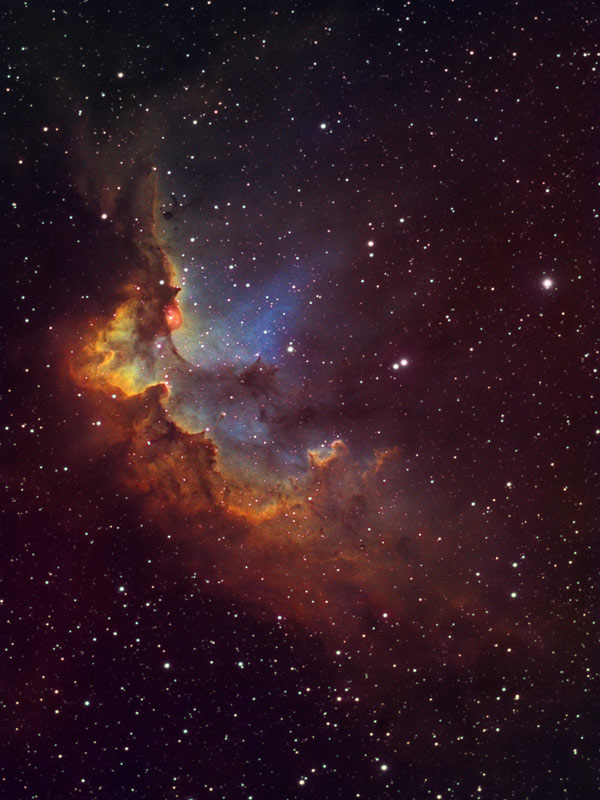Page 1 of 1
APOD: Halloween and the Wizard Nebula (2023 Oct 31)
Posted: Tue Oct 31, 2023 4:06 am
by APOD Robot
 Halloween and the Wizard Nebula
Explanation: Halloween's origin
Halloween and the Wizard Nebula
Explanation: Halloween's origin is ancient and astronomical. Since the fifth century BC,
Halloween has been celebrated as a
cross-quarter day, a day halfway between an
equinox (equal day / equal night) and a
solstice (minimum day / maximum night in the northern hemisphere). With a
modern calendar however, even though Halloween occurs today, the real cross-
quarter day will occur
next week. Another cross-quarter day is
Groundhog Day. Halloween's modern celebration retains
historic roots in
dressing to scare away the spirits of the dead. Perhaps a fitting tribute to this ancient holiday is
this closeup view of the
Wizard Nebula (NGC 7380). Visually, the interplay of stars, gas, and dust has created a shape that appears to some like a
fictional ancient sorcerer. Although the nebula may last only a few million years, some of the
stars being conjured from the gas by the
great gravitational powers may
outlive our Sun.
Re: APOD: Halloween and the Wizard Nebula (2023 Oct 31)
Posted: Tue Oct 31, 2023 6:05 am
by whwiii
um, you missed the wizard part

Re: APOD: Halloween and the Wizard Nebula (2023 Oct 31)
Posted: Tue Oct 31, 2023 2:48 pm
by Sa Ji Tario
Can someone limit the magician's silhouette?
Re: APOD: Halloween and the Wizard Nebula (2023 Oct 31)
Posted: Tue Oct 31, 2023 3:32 pm
by whwiii

wizard is above the APOD crop, only his hand shows
larger size
10/25/2009
Re: APOD: Halloween and the Wizard Nebula (2023 Oct 31)
Posted: Tue Oct 31, 2023 5:18 pm
by Ann
whwiii wrote: ↑Tue Oct 31, 2023 3:32 pm

wizard is above the APOD crop, only his hand shows
larger size
10/25/2009
The wizard is here?
Ann
Re: APOD: Halloween and the Wizard Nebula (2023 Oct 31)
Posted: Tue Oct 31, 2023 5:51 pm
by orin stepanek
I'm almost glad this can bo set aside for another year!

Re: APOD: Halloween and the Wizard Nebula (2023 Oct 31)
Posted: Tue Oct 31, 2023 5:59 pm
by whwiii
Ann wrote: ↑Tue Oct 31, 2023 5:18 pm
The wizard is here?
Ann
yes
Re: APOD: Halloween and the Wizard Nebula (2023 Oct 31)
Posted: Tue Oct 31, 2023 9:00 pm
by johnnydeep
orin stepanek wrote: ↑Tue Oct 31, 2023 5:51 pm
WizardCenter_McInnis_960.jpg
I'm almost glad this can bo set aside for another year!

And there's also a bat to be had:
Re: APOD: Halloween and the Wizard Nebula (2023 Oct 31)
Posted: Wed Nov 01, 2023 3:45 am
by Sa Ji Tario
Ann wrote: ↑Tue Oct 31, 2023 5:18 pm
whwiii wrote: ↑Tue Oct 31, 2023 3:32 pm

wizard is above the APOD crop, only his hand shows
larger size
10/25/2009
Wizard of the Wizard Nebula.png
The wizard is here?
Ann
Thanks Whwiii and Ann
Re: APOD: Halloween and the Wizard Nebula (2023 Oct 31)
Posted: Wed Nov 01, 2023 10:56 pm
by starsurfer
I much prefer seeing "true" colour images of this nebula and also north up.
 Halloween and the Wizard Nebula
Halloween and the Wizard Nebula